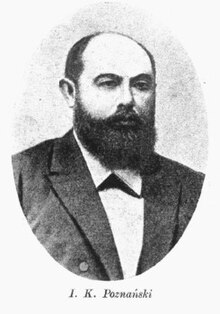Izrael Poznański: Difference between revisions
m Date maintenance tags and general fixes |
No edit summary |
||
| Line 5: | Line 5: | ||
One of the most eminent entrepreneurs in the Russian-dominated part of Poland, Poznański was the son of a Jewish merchant of [[Kowal]], who built up a textile empire and became, next to [[Karol Scheibler|Karl/Karol Scheibler]], the most important manufacturer of Łódź, a 'multicultural' city mainly populated by Poles (Catholic and Jewish) and Germans. The [[bourgeoisie]] of these groups was described in [[Władysław Reymont|Reymont's]] novel about Łódź ''[[The Promised Land]]'' (''Ziemia Obiecana''), later filmed by [[Andrzej Wajda]]. |
One of the most eminent entrepreneurs in the Russian-dominated part of Poland, Poznański was the son of a Jewish merchant of [[Kowal]], who built up a textile empire and became, next to [[Karol Scheibler|Karl/Karol Scheibler]], the most important manufacturer of Łódź, a 'multicultural' city mainly populated by Poles (Catholic and Jewish) and Germans. The [[bourgeoisie]] of these groups was described in [[Władysław Reymont|Reymont's]] novel about Łódź ''[[The Promised Land]]'' (''Ziemia Obiecana''), later filmed by [[Andrzej Wajda]]. |
||
The role of Poznański and other investors, typical representatives of early industrialization, has often been distorted, not only by partisan historians of the former socialist period (also influenced by subtle [[anti-Semitism]]).{{Fact|date=September 2008}} |
|||
Since 1989, the city of Łódź has rediscovered its industrial heritage, a unique ensemble of architecture, preserved despite two World Wars. The sites linked to Poznański's memory are among the most prominent ones of the city: the huge factory buildings in Ogrodowa Street; the nearby Poznański Palace, today a museum (including an exhibition about [[Arthur Rubinstein]], another 'Lodschermensch'); and Poznański's marble tomb in the Jewish cemetery, the biggest Israelite graveyard in Europe. Although Poznański was devout to the belief of his ancestors, it must be noted that the generous style of his grave monument is scarcely compatible with Jewish tradition, as that religion forbids any luxury for funerals and tombs. (From [http://www.findagrave.com/cgi-bin/fg.cgi?page=gr&GSmid=46785965&GRid=13378227& Findagrave] - copied by the author.) |
Since 1989, the city of Łódź has rediscovered its industrial heritage, a unique ensemble of architecture, preserved despite two World Wars. The sites linked to Poznański's memory are among the most prominent ones of the city: the huge factory buildings in Ogrodowa Street; the nearby Poznański Palace, today a museum (including an exhibition about [[Arthur Rubinstein]], another 'Lodschermensch'); and Poznański's marble tomb in the Jewish cemetery, the biggest Israelite graveyard in Europe. Although Poznański was devout to the belief of his ancestors, it must be noted that the generous style of his grave monument is scarcely compatible with Jewish tradition, as that religion forbids any luxury for funerals and tombs. (From [http://www.findagrave.com/cgi-bin/fg.cgi?page=gr&GSmid=46785965&GRid=13378227& Findagrave] - copied by the author.) |
||
Revision as of 21:17, 7 March 2009


Izrael Kalmanowicz Poznański (b. 1833 in Aleksandrów - 1900 in Łódź, Poland) was a textile magnate, philanthropist, a successful Polish-Jewish industrialist in Łódź, and the husband of Elenora Hertz Poznański.
One of the most eminent entrepreneurs in the Russian-dominated part of Poland, Poznański was the son of a Jewish merchant of Kowal, who built up a textile empire and became, next to Karl/Karol Scheibler, the most important manufacturer of Łódź, a 'multicultural' city mainly populated by Poles (Catholic and Jewish) and Germans. The bourgeoisie of these groups was described in Reymont's novel about Łódź The Promised Land (Ziemia Obiecana), later filmed by Andrzej Wajda.
Since 1989, the city of Łódź has rediscovered its industrial heritage, a unique ensemble of architecture, preserved despite two World Wars. The sites linked to Poznański's memory are among the most prominent ones of the city: the huge factory buildings in Ogrodowa Street; the nearby Poznański Palace, today a museum (including an exhibition about Arthur Rubinstein, another 'Lodschermensch'); and Poznański's marble tomb in the Jewish cemetery, the biggest Israelite graveyard in Europe. Although Poznański was devout to the belief of his ancestors, it must be noted that the generous style of his grave monument is scarcely compatible with Jewish tradition, as that religion forbids any luxury for funerals and tombs. (From Findagrave - copied by the author.)
The mausoleum of Izrael and Eleonora Hertz Poznański is probably the largest Jewish tombstone in the world. The mausoleum and mosaic covering the inside of the dome were restored in 1993.
Further reading
- More about Poznanski's Łódź can be found here.
- For the German reader, Döblin's Reise in Polen(about the Jewish Łódź of the 1920s).
- Description of Karl/Karol Scheibler's monument, the gravesite of another Lodz tycoon here.
